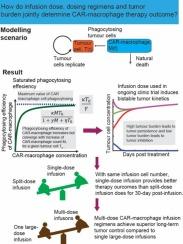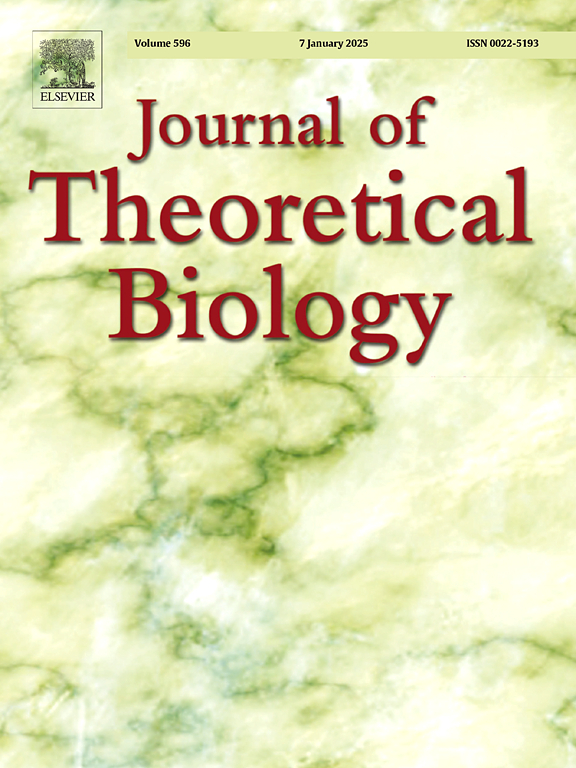数学模型表明,目前的car -巨噬细胞剂量对低输注前肿瘤负荷有效,但对高肿瘤负荷难以耐受。
IF 2
4区 数学
Q2 BIOLOGY
引用次数: 0
摘要
嵌合抗原受体(CAR)-巨噬细胞疗法是一种很有前途的治疗肿瘤的方法,由于抗原特异性吞噬和肿瘤清除。然而,肿瘤负荷、剂量和给药方案对治疗结果的确切影响仍然知之甚少。我们建立了常微分方程(ODE)数学模型,并利用参数推理分析了体外基于facs的吞噬实验数据,测试cd19阳性Raji肿瘤细胞对car -巨噬细胞的吞噬能力,发现car -巨噬细胞的吞噬效率随着Raji细胞和car -巨噬细胞浓度的增加而增加,但饱和。这种相互作用导致双稳态Raji细胞动力学;具体来说,在特定的car -巨噬细胞浓度范围内,低肿瘤负荷被有效抑制,而高肿瘤负荷仍然难以治愈。此外,我们的模型预测,当前临床试验通常建议的car -巨噬细胞剂量只有在肿瘤负荷较低时才能产生良好的治疗效果。对于总剂量固定的car -巨噬细胞分裂输注,首次高剂量car -巨噬细胞输注具有较好的治疗效果。最后,我们确定了替代输注方案:每月给药50亿个细胞,持续3个月,或每两个月给药70亿个细胞,持续6个月,可以有效抑制Raji细胞的复制,而不考虑肿瘤负荷。我们的研究结果强调了car -巨噬细胞治疗结果受到肿瘤负荷和不同给药方案的强烈影响。这项工作强调,减少肿瘤负担、增加首次输注car -巨噬细胞剂量和延长car -巨噬细胞持久性是实现持久反应的关键策略。本文章由计算机程序翻译,如有差异,请以英文原文为准。

Mathematical model suggests current CAR-macrophage dosage is efficient to low pre-infusion tumour burden but refractory to high tumour burden
Chimeric antigen receptor (CAR)-macrophage therapy is a promising approach for tumour treatment due to antigen-specific phagocytosis and tumour clearance. However, the precise impact of tumour burden, dose and dosing regimens on therapeutic outcomes remains poorly understood. We developed ordinary differential equation (ODE) mathematical modelling and utilised parameter inference to analyse in vitro FACS-based phagocytosis assay data testing CD19-positive Raji tumour cell against CAR-macrophage, and revealed that phagocytosing efficiency of CAR-macrophage increases but saturates as both Raji cell and CAR-macrophage concentrations increase. This interaction resulted in bistable Raji cell kinetics; specifically, within a particular range of CAR-macrophage concentration, low tumour burdens are effectively inhibited, while high tumour burdens remain refractory. Furthermore, our model predicted that CAR-macrophage dosages typically suggested by current clinical trials yield favourable therapeutic outcomes only when tumour burden is low. For split CAR-macrophage infusion with fixed total dosage, the first infusion with high CAR-macrophage dose delivers superior treatment outcomes. Finally, we identified alternative infusion regimens: five billion cells administered monthly for three months, or seven billion cells every two months for six months, can efficiently suppress Raji cell replication irrespective of tumour burden. Our findings highlight CAR-macrophage therapeutic outcomes are strongly influenced by both tumour burden and different dosing regimens. This work underscores that reducing tumour burden, increasing CAR-macrophage dose in the first infusion and prolonging CAR-macrophage persistence are key strategies for achieving durable responses.
求助全文
通过发布文献求助,成功后即可免费获取论文全文。
去求助
来源期刊
CiteScore
4.20
自引率
5.00%
发文量
218
审稿时长
51 days
期刊介绍:
The Journal of Theoretical Biology is the leading forum for theoretical perspectives that give insight into biological processes. It covers a very wide range of topics and is of interest to biologists in many areas of research, including:
• Brain and Neuroscience
• Cancer Growth and Treatment
• Cell Biology
• Developmental Biology
• Ecology
• Evolution
• Immunology,
• Infectious and non-infectious Diseases,
• Mathematical, Computational, Biophysical and Statistical Modeling
• Microbiology, Molecular Biology, and Biochemistry
• Networks and Complex Systems
• Physiology
• Pharmacodynamics
• Animal Behavior and Game Theory
Acceptable papers are those that bear significant importance on the biology per se being presented, and not on the mathematical analysis. Papers that include some data or experimental material bearing on theory will be considered, including those that contain comparative study, statistical data analysis, mathematical proof, computer simulations, experiments, field observations, or even philosophical arguments, which are all methods to support or reject theoretical ideas. However, there should be a concerted effort to make papers intelligible to biologists in the chosen field.

 求助内容:
求助内容: 应助结果提醒方式:
应助结果提醒方式:


